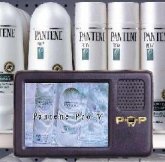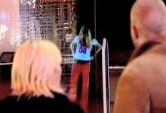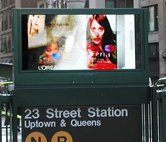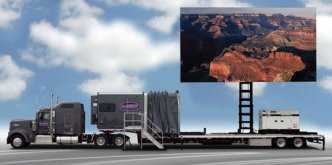

RESEARCH FROM THE INTERNATIONAL INFORMATICS
INSTITUTE
© 1995-2006 International
Informatics Institute, Inc. Some Rights Reserved.
This work is licensed under a
Creative Commons License.
Read our privacy guidelines.
Times Square led the way, but now video images that sell, entertain, demonstrate, brand and snag audience attention are popping up on main street, on the freeway, in shopping malls and on store-shelves.
Here's a form of television that's all commercials, all the time. Digital signage is replacing the printed billboard in hundreds of thousands of sites, compelling audience attention and challenging video producers to create very-short-form TV.
According to a Electronic Signage Networks as "Killer App," a pioneering white paper by Apogee Partners' Lyle Bunn, "by 2006 over 26,000 firms will use narrowcast systems, nearly 92,000 sites (i.e. locations or discreet premises) with at least one networked display, and an installed base of over 387,000 displays." Bunn writes that these 92,000 sites are less than 2% of the 1.6 million multiple-location retail and service firms that might implement networked digital signage systems.

 Clunky
CRTs with built-in VCR players have been a part of retail shops for years, but
small, thin LCDs make point-of-sale TV friendlier and more integrated into the
shopping experience. MPO
Videotronic's PopTV
Clunky
CRTs with built-in VCR players have been a part of retail shops for years, but
small, thin LCDs make point-of-sale TV friendlier and more integrated into the
shopping experience. MPO
Videotronic's PopTV division offers shelf-mount displays (left) for information and product
demonstrations, and
Panasonic's Retail TV operation configures store-wide systems (right)
that "engage the emotions and influence decisions."
division offers shelf-mount displays (left) for information and product
demonstrations, and
Panasonic's Retail TV operation configures store-wide systems (right)
that "engage the emotions and influence decisions."
 In
the main shopping street in Copenhagen after closing time, passersby watch a
young model perpetually trying on clothes and taking them off again in the
store window. She's a video projection onto a special one-way glass developed
by Vizoo, a cutting-edge Danish video firm,
whose showreel demonstrates TV that's seriously out-of-the-box.
In
the main shopping street in Copenhagen after closing time, passersby watch a
young model perpetually trying on clothes and taking them off again in the
store window. She's a video projection onto a special one-way glass developed
by Vizoo, a cutting-edge Danish video firm,
whose showreel demonstrates TV that's seriously out-of-the-box.
 In
New York, LED video signs have replaced printed billboards on 80 subway
entrances. Carrying messages from major national advertisers like Black &
Decker, Colgate-Palmolive, Disney, General Mills, Heinz, Kodak, LOreal, ABC,
FOX and Lee Jeans, the signs are wirelessly updated with new images. Another
article by Bunn in
Digital Signage Update reports on the
Lessons Learned in the first year of operation of the New York signs.
In
New York, LED video signs have replaced printed billboards on 80 subway
entrances. Carrying messages from major national advertisers like Black &
Decker, Colgate-Palmolive, Disney, General Mills, Heinz, Kodak, LOreal, ABC,
FOX and Lee Jeans, the signs are wirelessly updated with new images. Another
article by Bunn in
Digital Signage Update reports on the
Lessons Learned in the first year of operation of the New York signs.
 On
Highway 99 outside Vancouver, a 330 square foot video screen operated by the
LightVision Media Network plays commercials in front of 100,000 cars per
day. LightVision sells 10 second spots in a 90 minute loop. According to the
company's math, at an average 1.37 passengers per car, each ad gets 3.8
million impressions. (See
LightVision's video.)
On
Highway 99 outside Vancouver, a 330 square foot video screen operated by the
LightVision Media Network plays commercials in front of 100,000 cars per
day. LightVision sells 10 second spots in a 90 minute loop. According to the
company's math, at an average 1.37 passengers per car, each ad gets 3.8
million impressions. (See
LightVision's video.)
 On
the road at outdoor music festivals, sporting events and trade shows,
GoVision's GoBigger package inside
a 53 foot trailer delivers an 18 foot x 32 foot LED screen that can be raised
and rotated 16 feet above the crowd. A full control room, camera package and a
killer sound system are included. The company's video screens range
from 9 foot square to 45 foot x 75 foot. (And they have a
great .tv URL: jumbo.tv.)
On
the road at outdoor music festivals, sporting events and trade shows,
GoVision's GoBigger package inside
a 53 foot trailer delivers an 18 foot x 32 foot LED screen that can be raised
and rotated 16 feet above the crowd. A full control room, camera package and a
killer sound system are included. The company's video screens range
from 9 foot square to 45 foot x 75 foot. (And they have a
great .tv URL: jumbo.tv.)
Digital Signage Update Twice-a-month product news and buyers guide from business publisher Primedia
Webpavement Weblog Vendor-sponsored blog
AKA.TV A monthly on-line publication from the How and Why Group
SignWeb.com Moving Message Channel Video section of a web site for the sign industry
SignIndustry.com Sign industry product news and buyers guide site
Wirespring Weblog Vendor-sponsored blog
Dynamic Digital Signage Directory Created by Active Light, a plasma display supplier
D3 Magazine A new print/web publication from Kentucky publisher NetworldAlliance (may be defunct)
Outdoor TV is hot: Video ads are a fast-growing part of our daily shopping experience, and no big live event like a rock concert or a football game would be complete without real time TV showing us in pixels what we've already seen in real life. There's even the inevitable Homeland Security component since these video screens could be part of a local or even national Emergency Broadcasting Network.
IN3's Pervasive TV Project examines the shape of this new video landscape:
What is their effect on sales, on graphic communications, on marketing and branding, on our visual culture?
FREE
WEBCAST
IN3's research into the
development of video culminates
with our first Pay-Per-View webcast seminar.
Five Platforms examines all the places where video lives and paints
the big picture about television's future.
Learn more or ...
See the Driving Directions for a full list of features.
WATCH THE 90
SECOND TRAILER
ON YOUTUBE.COM